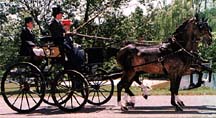

Hackney Horse


Introduction: If you have any comments or suggestions, please click here. The above left picture is of an old-style Hackney; I will be on the lookout for a modern one to compare it with, as well as a better picture of the Hackney in its traditional occupation--as coach and carriage horse.
Names: Hackney, Hackney Horse. There is also a Hackney Pony.
Origin:
Modern Hackneys, descendants of the old Norfolk Trotter or
Roadster, plus Dutch Friesian
(Harddraver) and Thoroughbred
blood, with some Fell
and Welsh
crossings for the ponies, were popular for use in most forms of
transport before the automobile. But today these spirited horses are too
fiery for any but the most experienced riders to handle in traffic, and their
exaggerated, breath-taking action belongs principally to the show ring.
A popular breed of light carriage horse used both in the
British Isles and the U.S. as a high-stepping, show-ring horse, the Hackney is
said to have originated in Norfolk, England, about 1729, from two stallions--an
Arabian and a Yorkshire--bred to Norfolk county mares. The original breed,
no longer in existence, was known as the Norfolk Roadster. The height,
weight, and body proportions generally of the Hackney horse are essentially the
same as those of the Standardbred. The word "hackney" is said to have come
from "nag," a nondescript horse, and from the Norman (French) hacquenée,
which combined the Latin Equus and the Anglo-Saxon knegan
(neigh).
Breeding: Breeding area and studs--chiefly England, Holland, USA; numerous large and small private studs. Hackney Horse Society. Developed from the old Norfolk Trotter (Roadster) which became famous in the late Middle Ages. First mention is made of the outstanding Hackneys bred in Norfolk in the fourteenth century. Improved towards the end of the last century (1800s) to become a purely luxury breed.
Description:
Action: Walk usually inadequate; outstanding but often irregular, unbelievably high-stepping knee action in the trot, not covering much ground and lacking in thrust form the hind legs.
Body: Well set and nicely carried neck. High, beautifully developed withers; long, strong back with sound muscles connecting with the straight quarters. Tail set high and gracefully carried. Usually very straight shoulders. Frequently lacking in the barrel.
Color: Bay, black or brown. Many white markings, broad blazes and white feet and cannons.
Head: Noble, very like the Thoroughbred.
Legs: Often very weak; back at the knee; usually very strong hocks.
Size: 14.3-15.3 hands. 15.2 to 16 hands.
Temperament: Rather highly strung.
Features: High-stepping trotter, famous for its exaggerated but graceful action. Light, very elegant; often carriage horse. Not very large, hard, noble lines.
Uses: Used in light carriages, for showing.
Accomplishments:
Curiosities: Two thousand years ago the Chinese had high-stepping horses, probably brought in by Spanish traders. In the 16th century, the number of trotting horses a landowner was compelled to keep was in the ratio to his wife's velvet bonnets.
Profiles:
Conclusion: